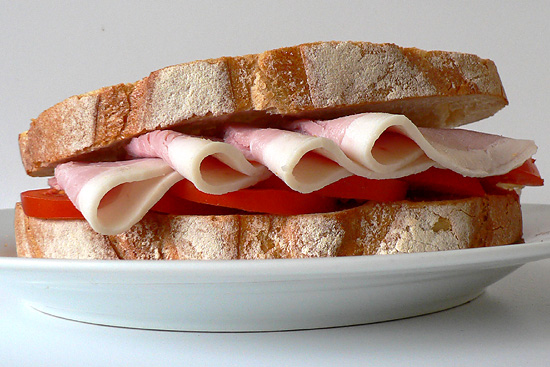About a year ago I replied to a comment on Pauline’s Ham and said: “…I have done this cure with a lot less liquid by using a vacuum bag and just putting 100 – 200 ml of brine cure in with the meat (after injecting, of course).” It was my intention, at that time, to write further about this with an explanation and more detail.

Contrary to popular belief, the reason’s not that I’m tight-fisted! There are also some technical reasons why it’s a good idea. They’re not related to injection-curing; it’s the immersion part of the cure that’s the potential cause for concern.
Now, let’s be right about this, meat’s been cured using injection followed by immersion – ‘pump and dunk’ – with no (apparent) problems for quite a time. And, before 2008, it wasn’t a problem because the EU set the maximum residual level of nitrite allowed in the meat, and that could be determined by testing.
In 2008, this changed; the laws were tightened and the level of cure permitted was not only reduced but was changed from being based on the residual level to being based on the ‘ingoing amount’ of cure instead.
That’s fine in the case of a dry cure, where you know by weight how much the ingoing amount is. And, with an injection cure, you know exactly what you’ve injected. But what about immersion curing? How much will the meat ‘suck up’ from the brine?
We were under the impression that we also knew that; it was assumed to be about 8% – 10% of the meat’s weight, in the same ratio as the ingredients in the brine cure.
Then we became aware of the US Food Safety and Inspection Service’s “Processing Inspectors’ Calculations Handbook”, which tells how to make the necessary calculations. It specifies two methods for calculating immersion brines: one for small pieces of meat and one for larger ones. Should we apply one of these to the immersion part of our procedure? If so, which one? Not a problem, you’d think, as the handbook gives instructions as to which one to use; but in reality, it is. You see, tests carried out by a US analytical scientist who’s also a hobby curer, show that for pieces of meat of the size most commonly cured at home, the specified rule doesn’t seem to work. His tests showed, that contrary to what the FSIS advise, the other rule applies.
The test results, from his piece of meat, indicate that the meat absorbs the ingredients from the brine very quickly, and in a way that is closest to FSIS method 2. This method states that the meat will try to become part of one system with the brine cure; it will become ‘in equilibrium’. The method of calculation is such that the more brine cure there is, the higher the amount of ingredients absorbed. It sounds daft, but they mean it! What they’re saying is, that if you take two identical 1kg pieces of meat, and put one into 2 litres of brine cure, and one into 5 litres, then the one that’s in 5 litres will absorb more of the salt, sugar and curing salt.
So how does this affect the meat when it’s been injected? Well, with the amounts of brine cure that I use in my recipes, once injected, it’s my belief that there’s little or no further pick-up from the short spell of time that it’s in the brine cure. Looking at the details for a piece of ham I cured in 2008, had the FSIS method of calculation been used for the cure, the meat should have had 5% salt in it from the immersion part of the cure; that’s double or triple the amount in average cooked ham from the supermarket. In fact, in side-by-side blind tests, my ham is less salty than theirs. I would stress, that of all the hundreds of hams that must have been made using my recipe, not one person has complained that it’s inedibly salty. Mark my words, if it was 5% salt, they would have.
So, if that’s the case, why am I bothering with all this? Well, firstly, there’s a remote possibility that I’m wrong; secondly, I tend to cure larger pieces of meat, around 4 – 5kg; I know many of you use smaller pieces of meat that may react more quickly in the brine cure; thirdly, you can never be too safe.
The FSIS do give advice about what to do when you use two methods of curing on one piece of meat. They say to calculate each part of the curing process separately. Because of what I’ve said above and for other reasons, I’m not happy that their advice is correct; by the very nature of the equilibrium method, the injected amount of brine cure must form part of the calculation for the equilibrium part of the cure. You can’t count it twice. So, which is it to be?
With that in mind, I’ve devised a cure that complies with both the injection curing calculations, and with those for immersion curing (had the brine cure not been injected). I have used FSIS method 2 to calculate it as an immersion cure. As far as I am aware, neither the EU nor the UK governments’ publish instructions or advice on how to calculate that ingoing levels of nitrite and nitrates comply with their laws.
The cure calculator is not in the same style as the rest of this site due to scripting issues: